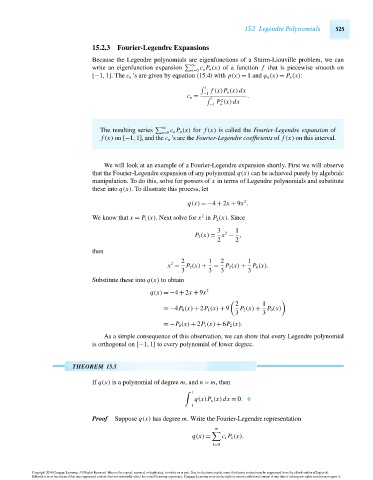Page 545 - Advanced_Engineering_Mathematics o'neil
P. 545
15.2 Legendre Polynomials 525
15.2.3 Fourier-Legendre Expansions
Because the Legendre polynomials are eigenfunctions of a Sturm-Liouville problem, we can
∞
write an eigenfunction expansion c n P n (x) of a function f that is piecewise smooth on
n=0
[−1,1].The c n ’s are given by equation (15.4) with p(x) = 1 and ϕ n (x) = P n (x):
1
f (x)P n (x)dx
−1
c n = .
1 2
−1 P (x)dx
n
∞
The resulting series n=0 c n P n (x) for f (x) is called the Fourier-Legendre expansion of
f (x) on [−1,1], and the c n ’s are the Fourier-Legendre coefficients of f (x) on this interval.
We will look at an example of a Fourier-Legendre expansion shortly. First we will observe
that the Fourier-Legendre expansion of any polynomial q(x) can be achieved purely by algebraic
manipulation. To do this, solve for powers of x in terms of Legendre polynomials and substitute
these into q(x). To illustrate this process, let
2
q(x) =−4 + 2x + 9x .
2
We know that x = P 1 (x).Nextsolve for x in P 2 (x). Since
3 1
2
P 2 (x) = x − ,
2 2
then
2 1 2 1
2
x = P 2 (x) + = P 2 (x) + P 0 (x).
3 3 3 3
Substitute these into q(x) to obtain
q(x) =−4 + 2x + 9x 2
2 1
=−4P 0 (x) + 2P 1 (x) + 9 P 2 (x) + P 0 (x)
3 3
=−P 0 (x) + 2P 1 (x) + 6P 2 (x).
As a simple consequence of this observation, we can show that every Legendre polynomial
is orthogonal on [−1,1] to every polynomial of lower degree.
THEOREM 15.5
If q(x) is a polynomial of degree m, and n > m, then
1
q(x)P n (x)dx = 0.
−1
Proof Suppose q(x) has degree m. Write the Fourier-Legendre representation
m
q(x) = c k P k (x).
k=0
Copyright 2010 Cengage Learning. All Rights Reserved. May not be copied, scanned, or duplicated, in whole or in part. Due to electronic rights, some third party content may be suppressed from the eBook and/or eChapter(s).
Editorial review has deemed that any suppressed content does not materially affect the overall learning experience. Cengage Learning reserves the right to remove additional content at any time if subsequent rights restrictions require it.
October 14, 2010 15:20 THM/NEIL Page-525 27410_15_ch15_p505-562

